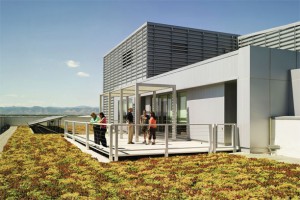The results are in…when it comes to the business case for sustainability, green buildings “walk the talk.”
In a recently issued white paper, GSA outlined the results of a post-occupancy evaluation study of 22 green federal buildings from across the country; the findings compared to national average commercial buildings:
- They cost less to maintain, by 19%
- They use less energy and water, by 25%
- They emit fewer carbon dioxide emissions, by 36% and
- They have more satisfied occupants, by 27%.
The study, conducted by the Pacific Northwest National Laboratory, built on a good indication of the potential for increased productivity and performance pilot research completed two years ago, with similarly impressive results.
For more than a decade, the federal government has declared its commitment to sustainable building though presidential directives and executive orders, congressional legislation and governmentwide policies. PBS began its sustainable design program in 1999, and they completed their first green roof in 1975.
There’s no question that focusing on sustainability is the right thing to do for our environment: commercial buildings account for 18% of the nation’s energy use. The numbers show that greening federal buildings in most cases makes good business sense, as well. By looking critically at real world performance, this report demonstrates that the GSA is very much on track to achieve its green building goals, and that GSA is delivering high-performance, sustainable workplaces federal agencies need to fulfill their missions on behalf of the American people.
Find out more by reading the white paper. BD+C
--
Related Stories
| Aug 11, 2010
ZweigWhite names its fastest-growing architecture, engineering, and environmental firms
Management consulting and research firm ZweigWhite has identified the 200 fastest-growing architecture, engineering, and environmental consulting firms in the U.S. and Canada for its annual ranking, The Zweig Letter Hot Firm List. This annual list features the design and environmental firms that have outperformed the economy and competitors to become industry leaders.
| Aug 11, 2010
SSOE, Fluor among nation's largest industrial building design firms
A ranking of the Top 75 Industrial Design Firms based on Building Design+Construction's 2009 Giants 300 survey. For more Giants 300 rankings, visit http://www.BDCnetwork.com/Giants
| Aug 11, 2010
Guggenheim to host live online discussion of Frank Lloyd Wright exhibition
The Solomon R. Guggenheim Museum launches the Guggenheim Forum, a new series of moderated online discussions among experts from a variety of fields that will occur in conjunction with major museum exhibitions.
| Aug 11, 2010
Best AEC Firms of 2011/12
Later this year, we will launch Best AEC Firms 2012. We’re looking for firms that create truly positive workplaces for their AEC professionals and support staff. Keep an eye on this page for entry information. +
| Aug 11, 2010
Report: Building codes and regulations impede progress toward uber-green buildings
The enthusiasm for super green Living Buildings continues unabated, but a key stumbling block to the growth of this highest level of green building performance is an existing set of codes and regulations. A new report by the Cascadia Region Green Building Council entitled "Code, Regulatory and Systemic Barriers Affecting Living Building Projects" presents a case for fundamental reassessment of building codes.
| Aug 11, 2010
Call for entries: Building enclosure design awards
The Boston Society of Architects and the Boston chapter of the Building Enclosure Council (BEC-Boston) have announced a High Performance Building award that will assess building enclosure innovation through the demonstrated design, construction, and operation of the building enclosure.
| Aug 11, 2010
Portland Cement Association offers blast resistant design guide for reinforced concrete structures
Developed for designers and engineers, "Blast Resistant Design Guide for Reinforced Concrete Structures" provides a practical treatment of the design of cast-in-place reinforced concrete structures to resist the effects of blast loads. It explains the principles of blast-resistant design, and how to determine the kind and degree of resistance a structure needs as well as how to specify the required materials and details.







